Curious about Actual OMG OCUP (OMG-OCUP2-FOUND100) Exam Questions?
Here are sample OMG Certified UML Professional 2 (OCUP 2) - Foundation Level (OMG-OCUP2-FOUND100) Exam questions from real exam. You can get more OMG OCUP (OMG-OCUP2-FOUND100) Exam premium practice questions at TestInsights.
Choose the correct answer:
Which element in the following sequence diagram could correspond to a signal?
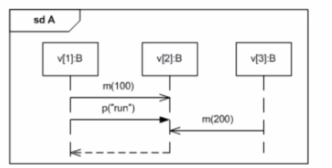
Correct : D
In UML sequence diagrams, a signal is typically represented as an asynchronous message without a return value. Asynchronous messages are often denoted with an open arrowhead, and they can represent the sending of a signal.
Looking at the diagram provided, 'p' is sent from 'v2[C]' to 'v3[B]' with an open arrowhead, which indicates that it is an asynchronous message. This fits the common representation of a signal, as it does not expect a response.
'A', 'B', and 'C' do not represent signals in the context of a sequence diagram: A) 'v' is not shown in the diagram; it might refer to a lifeline, which is not a signal. B) 'B' refers to a class or object type and not a message or signal. C) 'm' is represented as a synchronous message (as it has a return arrow), which is not typical for signals.
Therefore, the correct answer is:
D . p
Start a Discussions
Choose the correct answer:
Which statement is always true about the following sequence diagram?
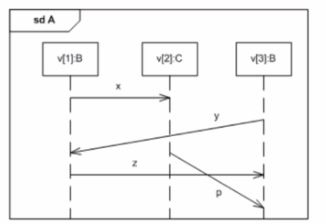
Correct : B
In the second diagram provided, we see four messages: 'x', 'y', 'z', and 'p'. The vertical positioning of these messages indicates their order in time.
Option A states that 'Sending message x is the first occurrence that happens.' This could be true but is not necessarily always true, as there could be other messages or interactions before 'x' that are not shown in this part of the diagram.
Option B states that 'Sending message z will happen after receiving message x.' This is always true because the lifeline for 'v2[C]' shows the reception of 'x' before sending 'z'. In sequence diagrams, the vertical position indicates the sequence of events, and 'z' is clearly below 'x' on the 'v2[C]' lifeline.
Option C, 'Sending message y will happen before sending message z,' is not necessarily true because the messages 'y' and 'z' are sent by different lifelines, and there is no explicit ordering between them.
Option D, 'Sending message p will happen before receiving message y,' is not necessarily true as 'p' and 'y' involve different lifelines, and no ordering is specified between these interactions.
Therefore, the correct answer is:
B . Sending message z will happen after receiving message x.
Start a Discussions
Choose the correct answer:
How many execution occurrence specifications are there in total on the diagram below?
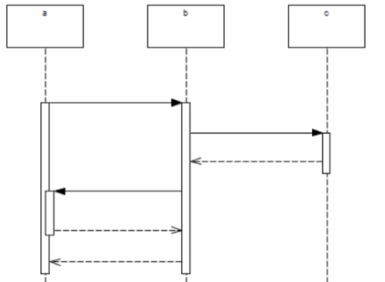
Correct : D
An execution occurrence specification in UML sequence diagrams is represented by a thin rectangle on a lifeline. It shows that an instance is performing an action over a period of time.
In the provided sequence diagram, we can see three such thin rectangles on lifeline 'b', which indicates that there are three execution occurrence specifications.
One for the message that comes from 'a' to 'b'.
Another one for the message that 'b' sends to 'c'.
And the last one for the return message from 'c' to 'b'.
There are no execution occurrence specifications on lifelines 'a' and 'c'.
Therefore, the correct answer is:
D . 3
Start a Discussions
Choose the correct answer:
Consider the following diagram fragment:
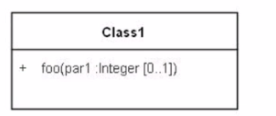
Which statement is correct about the parameter part?
Correct : A
In UML, when a class diagram shows an operation with a parameter that has a multiplicity of [0..1], it indicates that the parameter is optional. The range [0..1] means that the parameter can have 0 or 1 occurrence. This does not mean it accepts a collection, nor does it specify the values it accepts (it specifies how many times the parameter can occur).
The correct interpretation of the parameter par1 : Integer [0..1] is:
A . It is optional.
B is incorrect because the multiplicity [0..1] does not mean a collection of items; rather, it signifies that the parameter can be omitted or present, but not multiple times. C is incorrect because the multiplicity [0..1] does not constrain the values to 0 or 1; it refers to the number of instances of the parameter. D is incorrect because [0..1] is not a range of values but a range of occurrences or instances of the parameter.
Therefore, the correct answer is:
A . It is optional.
Start a Discussions
Choose the correct answer:
The Sensor Controller state machine shown below is at rest in the Ready state. The acquireData event occurs.
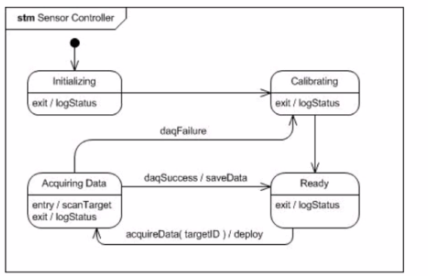
What Is the complete sequence of behaviors that executes before the state machine comes to rest in the Acquiring Data state?
Correct : D
The provided image depicts a block diagram of a sensor controller represented as a state machine. The state machine transitions between the following states:
Initializing
Calibrating
Ready
Acquiring Data
The question specifies the state machine starts in the Ready state and the acquireData event triggers the transition.
Analyzing the image, we can identify the following behaviors for the scenario:
logStatus: This behavior is depicted in the diagram as the first action upon exiting the Ready state. It most likely logs the current state of the sensor controller.
deploy: The transition from Ready to Acquiring Data triggers thedeploybehavior. This likely involves preparing the sensor for data acquisition.
scanTarget: Upon entering the Acquiring Data state, thescanTargetbehavior is initiated. This suggests the sensor controller is actively collecting data from the target.
Therefore, the complete sequence of behaviors is logStatus, followed by deploy, and lastly scanTarget, before reaching the Acquiring Data state.
Justification for excluding other options:
Option A (deploy only) excludes the initial state logging and target scanning actions.
Option B (logStatus.deploy) excludes the target scanning upon entering the Acquiring Data state.
Option C (deploy, scanTarget) omits the initial state logging.
Option E (logStatus.deploy.scanTarget.logStatus) includes an extralogStatusaction after target scanning, which is not supported by the diagram.
In conclusion, based on the state machine diagram and the behavior descriptions, option D (logStatus.deploy.scanTarget) accurately reflects the sequence of actions that occur before the sensor controller arrives at the Acquiring Data state.
Start a Discussions
Total 90 questions